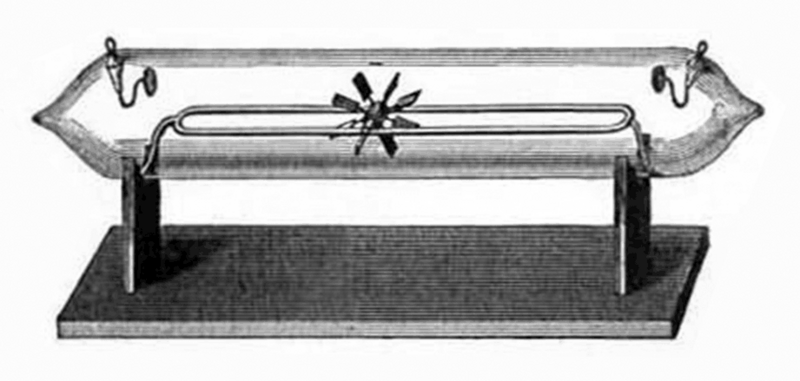Archivo: Crookes paddlewheel tube

Descripción: Drawing of an experimental Crookes tube with a paddlewheel inside, built by William Crookes around 1879. It was called the 'railway' tube, since as the paddlewheel turned it slowly rolled down the rails from one end of the tube to the other. The purpose of the tube was to determine whether cathode rays had mass. The tube was evacuated to a pressure of about 10-6 to 10-7 atmosphere. When the electrodes at each end of the tube were attached to a source of high voltage DC electricity, a beam of cathode rays (electrons) passed down the tube from the cathode to the anode. The upper paddles of the light paddlewheel were in the path of the beam. Crookes found that when the voltage was applied the paddlewheel turned in a direction away from the cathode. He concluded that the momentum of the rays was providing the force which turned the wheel, indicating that cathode rays had mass. However in 1903, J. J. Thompson showed that the motion of the paddlewheel was actually caused by the radiometer effect. When the cathode rays struck the paddle, they heated it. The air next to the hot side of the paddle expanded, pushing the paddle away. All this experiment really showed was that cathode rays could heat objects. Alterations to image: removed figure number and yellowish tint to page, converted to 32 greyscale PNG.
Título: Crookes paddlewheel tube
Créditos: Downloaded September 27, 2008 from William Crookes (November 1879) On Radiant Matter, Popular Science Monthly, London, p.158 on Jeff Behary's, Turn of the Century Electrotherapy Museum website
Autor(a): William Crookes
Permiso: Public Domain - William Crookes died 1919
Términos de Uso: Dominio Público
Licencia: Dominio Público
¿Se exige la atribución?: No
Usos del archivo
La siguiente página enlaza a este archivo:

